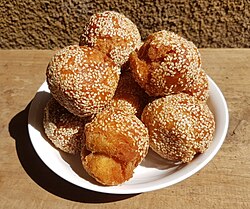
A doughnut is a type of pastry made from leavened fried dough. It is popular in many countries and is prepared in various forms as a sweet snack that can be homemade or purchased in bakeries, supermarkets, food stalls, and franchised specialty vendors. Doughnut is the traditional spelling, while donut is the simplified version; the terms are used interchangeably.

A Danish pastry is a multilayered, laminated sweet pastry in the viennoiserie tradition. It is thought that some bakery techniques were brought to Denmark by Austrian bakers, and originated the name of this pastry. The Danish recipe is however different from the Viennese one and has since developed into a Danish specialty.

Sufganiyah is a round jelly doughnut eaten around the world during the Jewish festival of Hanukkah. The doughnut is deep-fried, injected with jam or custard, and then topped with powdered sugar. The doughnut recipe originated in Europe in the 16th century, and by the 19th century was known as a Berliner in Germany. Polish Jews, who called it a ponchki, fried the doughnut in schmaltz rather than lard due to kashrut laws. The ponchik was brought to Israel by Polish Jewish immigrants, where it was renamed the sufganiyah based on the Talmud's description of a "spongy dough".

A Luther Burger, or doughnut burger, is a hamburger or cheeseburger with one or more glazed doughnuts in place of the bun. These burgers have a disputed origin, and tend to run between approximately 800 and 1,500 calories.

Mister Donut is an international chain of doughnut stores, operating mostly in Asia. It was founded in the United States in 1956 by Harry Winokur. Primary offerings include doughnuts, coffee, muffins and pastries. After being acquired by Allied Domecq in 1990, most of the North American stores became Dunkin' Donuts. Outside of the United States, Mister Donut maintains a presence in Japan, El Salvador, the Philippines, Thailand, Indonesia, Taiwan, and Singapore.
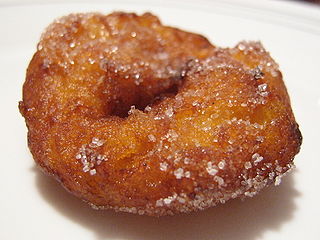
A buñuelo (Spanish:[buˈɲwelo], alternatively called boñuelo, bimuelo, birmuelo, bermuelo, bumuelo, burmuelo, or bonuelo, is a fried dough fritter found in Spain, Latin America, and other regions with a historical connection to Spaniards, including Southwest Europe, the Balkans, Anatolia, and other parts of Asia and North Africa. Buñuelos are traditionally prepared at Christmas. It will usually have a filling or a topping. In Mexican cuisine, it is often served with a syrup made with piloncillo.

Jiandui or sesame balls are a type of fried Chinese pastry made from glutinous rice flour. The pastry is coated with sesame seeds on the outside and is crisp and chewy after immediately being cooked. Inside the pastry is a large hollow, caused by the expansion of the dough. The hollow of the pastry is filled with a filling usually consisting of lotus paste, or alternatively, sweet black bean paste, or red bean paste.

Pinaypay, also known as maruya, is a type of banana fritter from the Philippines. It is usually made from saba bananas. The most common variant is prepared by cutting bananas into thin slices on the sides and forming it into a fan-like shape, and coating it in batter and deep frying them. They are then sprinkled with sugar. Though not traditional, they may also be served with slices of jackfruit preserved in syrup or ice cream. Pinaypay are commonly sold as street food and food sellers at outdoor though they are also popular as home-made merienda snacks among Filipinos.
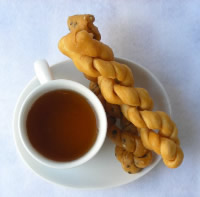
Mahua or Fried Dough Twist is a Chinese dough twist that is fried in peanut oil. It has a shiny and golden look. It is prepared in various ways with different flavors, which range from sweet to spicy, and usually has a dense and crisp texture. The origin of Mahua can be traced back to thousands of years ago. Many places have a tradition of eating Mahua, and Mahua is considered a signature food of the northern Chinese city of Tianjin.
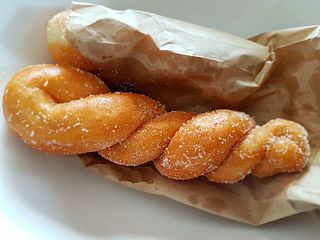
Shakoy, also known as lubid-lubid or bicho bicho, is a traditional Filipino deep-fried twisted doughnut. It is traditionally made with flour, sugar, salt, and yeast and deep-fried. It is then sprinkled with white sugar. Variants of shakoy can also be made with other kinds of flour, most notably with rice flour, which results in a chewier version that is also usually coated with sesame seeds. Dry and crunchy versions of shakoy, which are usually much smaller, are known as pilipit.

Twisted doughnuts are yeast donuts or sticks of pastry made from wheat flour or glutinous rice flour, deep-fried in oil. In China, they are known as mahua (麻花); in Korea, they are known as kkwabaegi (꽈배기), and in the Philippines, they are known as shakoy and pilipit, in Japan, they are known as sakubei.

Moche are Pampangan glutinous rice balls with a bean paste filling. Made from galapong and filled with mung- or red bean paste, it is shaped into balls or ovals. Bukayo may also be used. It is then boiled in water until it floats. It is then sprinkled with sesame seeds or crushed peanuts and served hot with a sauce made from sweetened coconut milk (gata).
Mache or matse are glutinous rice balls originally plain or flavored with coconut and pandan from the province of Laguna, Philippines. It is made from boiled galapong usually plain or with pandan flavoring. It is then filled with toasted sesame seeds and sugar and rolled in more glutinous rice flour or powdered sugar for more sweetness. The resulting dish is characteristically white in color or green due to the pandan extracts.
Kumukunsi is a traditional Filipino deep-fried doughnut originating from the Maguindanao people. It is made from rice flour, duck eggs, and sugar. It is traditionally fried into spiral shapes. It has a creamy flavor, similar to pancakes.

Caycay is a Filipino crunchy layered cookie coated in syrup (latik) or honey and rolled in coarsely ground toasted peanuts. It originates from the islands of Bohol and Cebu and is a common specialty in the southern Visayas islands and Mindanao. The name comes from the verb kaykay which means "to dig up" in the Cebuano language, in reference to the step of coating the cookies in ground peanuts. Some versions coat the cookies in sesame seeds instead of peanuts.

Linga, also known as longa, are Filipino cookies originating from Davao del Sur in the Philippines. The name comes from sesame seeds, which are known locally as linga in the Visayan languages or longa in the Davaoeño language. They are made from flour, sugar, salt, shortening, and sesame seeds. They are characteristically flat and baked until they are a deep brown color. They range in shape and size from small and circular to large and oblong. They are usually dipped in hot drinks like coffee or tsokolate before eating.
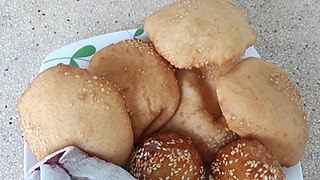
Ham chim peng, also spelt hum chim peng, known in Singapore and Malaysia as haam ji peng, hum ji peng, or ham ji peng, is a deep-fried hollow doughnut of Cantonese origin. Commonly eaten as a breakfast food, it is sometimes fried with a coating of sesame seeds.
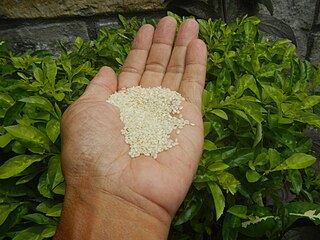
A food allergy to sesame seeds has prevalence estimates in the range of 0.1–0.2% of the general population, and are higher in the Middle East and other countries where sesame seeds are used in traditional foods. Reporting of sesame seed allergy has increased in the 21st century, either due to a true increase from exposure to more sesame foods or due to an increase in awareness. Increasing sesame allergy rates have induced more countries to regulate food labels to identify sesame ingredients in products and the potential for allergy. In the United States, sesame became the ninth food allergen with mandatory labeling, effective 1 January 2023.
